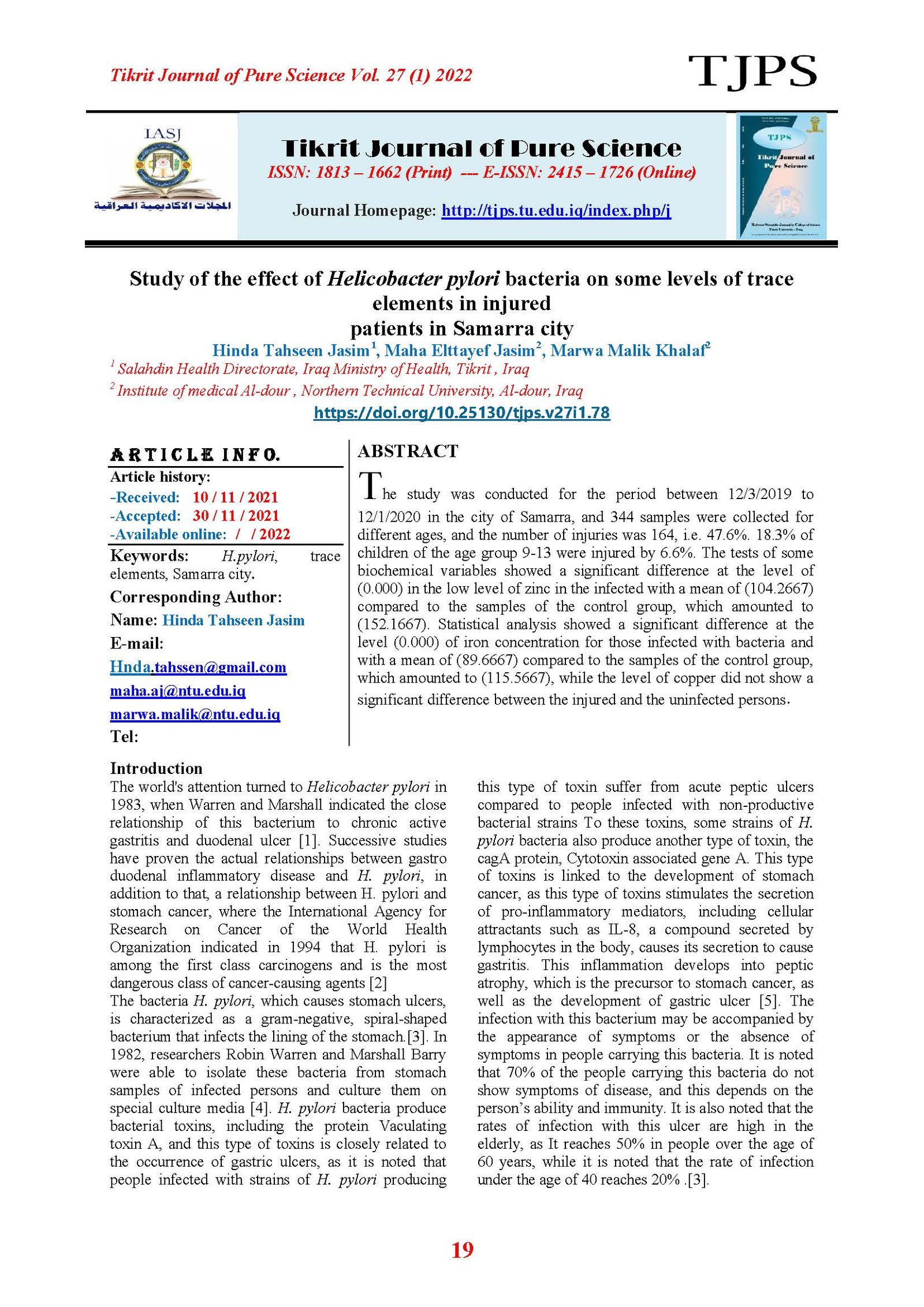Study of the effect of Helicobacter pylori bacteria on some levels of trace elements in injured patients in Samarra city
Main Article Content
Abstract
The study was conducted for the period between 12/3/2019 to 12/1/2020 in the city of Samarra, and 344 samples were collected for different ages, and the number of injuries was 164, i.e. 47.6%. 18.3% of children of the age group 9-13 were injured by 6.6%. The tests of some biochemical variables showed a significant difference at the level of (0.000) in the low level of zinc in the infected with a mean of (104.2667) compared to the samples of the control group, which amounted to (152.1667). Statistical analysis showed a significant difference at the level (0.000) of iron concentration for those infected with bacteria and with a mean of (89.6667) compared to the samples of the control group, which amounted to (115.5667), while the level of copper did not show a significant difference between the injured and the uninfected persons
Article Details

This work is licensed under a Creative Commons Attribution 4.0 International License.
Tikrit Journal of Pure Science is licensed under the Creative Commons Attribution 4.0 International License, which allows users to copy, create extracts, abstracts, and new works from the article, alter and revise the article, and make commercial use of the article (including reuse and/or resale of the article by commercial entities), provided the user gives appropriate credit (with a link to the formal publication through the relevant DOI), provides a link to the license, indicates if changes were made, and the licensor is not represented as endorsing the use made of the work. The authors hold the copyright for their published work on the Tikrit J. Pure Sci. website, while Tikrit J. Pure Sci. is responsible for appreciate citation of their work, which is released under CC-BY-4.0, enabling the unrestricted use, distribution, and reproduction of an article in any medium, provided that the original work is properly cited.
References
[1] Warren, J.R.; Marshall, B.J. (1983). Unidentified curved bacilli on gastric epithelium in active chronic gastritis, Lancet, i: 1273.
[2] Versalovic, J. & Fox, J.G. (1999). Helicobacter Manual of clinical microbiology, Vol. 1, Washington. 727-738.
[3] Olson, J.W. & Maier, R.J. (2002). Molecular hydrogen as an energy source for Helicobacter pylori. Science . 298 (5599): 1788–90.
[4] Blaser, M.J. (2005). An endangered species in the stomach. Sci. Am. 292 (2): 38–45.
[5] Mayer, E.A.; Bradesi, S.; Chang, L.; Spiegel, B.M.R.; Bueller, J.A. & Naliboff, B.D. (2008). Functional GI disorders: from animal models to drug development. Gut. 57: 384–404
[6] Manco, M.; Putignani, L. and Bottazzo, G.F. (2010). Gut microbiota, lipopolysaccharides, and innate immunity in the pathogenesis of obesity and cardiovascular risk. Endocr Rev. 31(6): 817–844.
[7] Assal, A.H. Gad, M.A. El Badawy, R.M. Emar, N.M. and Soliman, M.S. (2013). The Association between Helicobacter pylori Infection and Insulin Resistance. The International Medical Journal Malaysia. 12 (1): 49-52.
[8] Forman, D. & Webb, P. (1993). Geographic distribution & association with gastric cancer. In: Helicobacter pylori infection, by: Northfield, T.C.; Mendall, M. & Goggin, P.M., Kluwer academic publishers, Dordrecht, U.K., pp. 11-20.
[9] Salgueiro J, Zubillaga M, Goldman C, et al. (2004). Review article: is there a link between micronutrient malnutrition and Helicobacter pylori infection ? Aliment Pharmacol Ther; 20:1029–34.
[10] Bohr UR, Annibale B, Franceschi F, et al. (2007). Extragastric manifestations of Helicobacter pylori infection—other Helicobacters. Helicobacter; 12 (Suppl 1):45–53.
[11] Capurso G, Ricci R, Panzuto F, et al. (2003). Intragastric ascorbic but not uric acid is depleted in relation with the increased pH in patients with atrophic body gastritis and H. pylori gastritis. Helicobacter; 8: 300–6.
[12] Baysoy G, Ertem D, Ademoglu E, et al. (2004). Gastric histopathology, iron status and iron deficiency anemia in children with Helicobacter pylori infection. J Pediatr Gastroenterol Nutr; 38:146–51
[13] Lewise, S.M.; Bain, B.J. & Bates, I. (2001). Dacie and Lewis practical hematology. 19th ed. Churchill livingstone : 1-5.
[14] Megraud, F. et al. (1989). Seropidemiology of Campylobacter pylori infection in various populations J. Clin. Micro .27:1870- 3.
[15] Pesce, A.J., and Kaplan, L.A . (1987). Methods in Clinical Chemistry. Mosby Company.527,543-596.
[16] Jacques, V., and Rita, C. (1989). Trace. Elements in Human Plasma or Serum. CRC Press. P:37-135.
[17] Francesco, F.; et al.( 2014 ) Role of Helicobacter Pylori infection on nutrition and Metabo-lism. World. J. Gastroenterol. 20 (36) PP.12809-12817
[18] Akcam, M. (2010). Helicobacter pylori and Micronutrients. Indian Pediatrics. 47:119-120.
[19] Victor, M.; et al . (2006). Iron Deficiencyand Helicobacter pylori Infection in the Unit-ed States. Ame. Journal. of Epid. 163 PP. 127–134. 2006.
[20] Yuan, W.El.( 2010). Iron deficiency anemia in Helicobacter Pylori in fection ; meta-anaiysi of randomized controlled triais.Sca J Gas.45(6) PP.665-676.
[21] Collett, J.A.; Burt, M.J.; Frampton, C.M. (1999). Seroprevalence of Helicobacter Pylori in the adult population of Christchurch: risk factors and relation shipto dyspeptic symptoms and iron studies. J. N. Z. 112:292-5.
[22] Health benefits and risks of copper", www.medicalnewstoday.com, Retrieved 27-01-2020. Edited.
